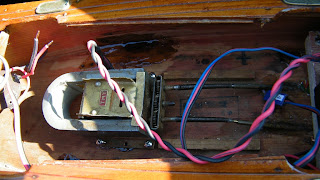These fine nights of September when Orion rises early the morning above the horizon, and Jupiter dominates the sky, its a pleasure to use the small ETX-70 telescope guided by its Autostar 494 controller. That telescope costed a mere 200 Euros at Lidl and in my opinion it isn't just a fine little telescope for the beginer, but it's also perfect for land surveing. When Lidl sold its Bresser microscope (another 60 Euros welll spend), it supplied it with a USB camera that fits not only to the microscope , but via an (supplied) adapter to the 1.25' eyepiece holder of the ETX-70. Even though the USB video adapter has a resolution of just 640 x 480 pixel , it is very good for land surveying as shown on the following video. At this case the distance to the subject (the Mi-8 Helicopter) was about 2.5 kilometers, temperature was about 27 deg. C, a sea area existed between the scope and the target and atmospheric conditions far from perfect. Barlows 3x lens was also used that deteriorated the resolution but I wanted to push it to its limits.
From the point of view of an electronics engineer the most interesting feature of the ETX-90 , is the precise guiding mechanism which can be controled by the computer's serial port. All you need is the optional 506 cable set from Meade which is actually an RS232 to I2C adapter that connects to the AUX port of the microscope. A lot of info is written about Meade's serial protocol but the best way to learn about it (exactly as I did) is to tap the serial cable and spy on the data when controlling the telescope with a proper software such as Drsoft 's Meade control panel , Carte des Ciels or Stellarium. A much more elegant solution to taping the cable is to duplicate the controling serial port using a serial to ip server, and open a teminal (like TeraTerm) at 9600N81 to view and log the traffic.After all my finds were :
#:Mn# Slew north (up)
#:Ms# Slew south (down)
#:Me# Slew east (left)
#:Mw# Slew west (right)
#:Mw##:Mn# Slew right up (NW)
#:Mw##:Ms# Slew right down (SW)
#:Me##:Mn# Slew left up (NE)
#:Me##:Ms# Slew left down (SE)
#:Qn##:Qs##:Qe##:Qw# Stop movement after above commands
#:Q# Stop movement for all motors
#:Sw2# Slew speed slow
#:Sw3# Slew speed medium
#:Sw4# Slew speed fast
FOCUS CONTROL - there isn't any focuser on the scope - we will talk about it later.
#:F+# Focus +
#:F-# Focus -
#:FQ# Focus Stop
#:FF# Fast Focus
#:FS# Slow Focus
After reading the excellent info on http://www.weasner.com I learn that : " when typing a single control-F on the terminal the Autostar should echo an "A" or "P" depending upon whether it's
set up as Alt/Az or Polar mount status and when typing #:GVF# it should respond with its identification string, including the word Autostar and a time and date (when that firmware version
was built at Meade) ".
Indeed :
Ctrl -F ---> A
#:GVF# ---> #Autostar|A|12Ea #
#:Mn# Slew north (up)
#:Ms# Slew south (down)
#:Me# Slew east (left)
#:Mw# Slew west (right)
#:Mw##:Mn# Slew right up (NW)
#:Mw##:Ms# Slew right down (SW)
#:Me##:Mn# Slew left up (NE)
#:Me##:Ms# Slew left down (SE)
#:Qn##:Qs##:Qe##:Qw# Stop movement after above commands
#:Q# Stop movement for all motors
#:Sw2# Slew speed slow
#:Sw3# Slew speed medium
#:Sw4# Slew speed fast
FOCUS CONTROL - there isn't any focuser on the scope - we will talk about it later.
#:F+# Focus +
#:F-# Focus -
#:FQ# Focus Stop
#:FF# Fast Focus
#:FS# Slow Focus
After reading the excellent info on http://www.weasner.com I learn that : " when typing a single control-F on the terminal the Autostar should echo an "A" or "P" depending upon whether it's
set up as Alt/Az or Polar mount status and when typing #:GVF# it should respond with its identification string, including the word Autostar and a time and date (when that firmware version
was built at Meade) ".
Indeed :
Ctrl -F ---> A
#:GVF# ---> #Autostar|A|12Ea #





















